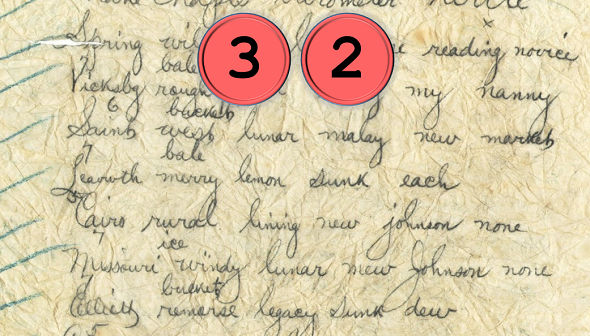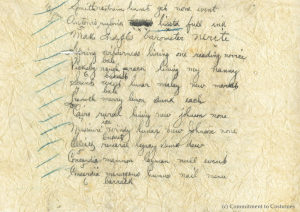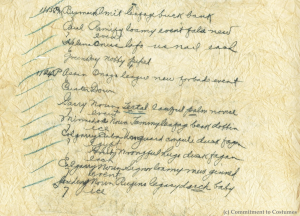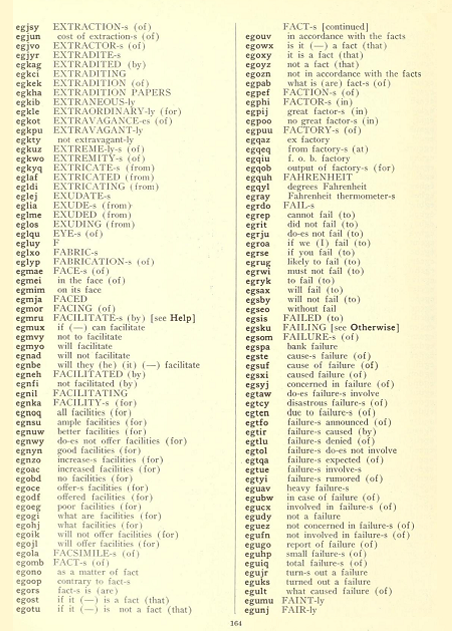In 2014 Maryland-based costume collector Sara Rivers-Cofield discovered an encrypted note in an antique silk dress. This cryptogram is unsolved to date.
Click here for the complete top 50 list
“A curator at work, a collector at home.” This is how Sara Rivers-Cofield describes her interest in antique costumes. In addition, she writes a blog on the subject (Commitment to Costumes). Three years ago she acquired a piece that she describes as a “mid-1880s two-piece bustle dress of bronze silk with striped rust velvet accents and lace cuffs”.
The cryptogram
All this doesn’t seem terribly relevant for the target group of Klausis Krypto Kolumne. However, this changed when Sara made an interesting discovery. On her blog she wrote:
The […] discovery arose when I turned the skirt inside out; there was a pocket! Okay, neat, but not earth shattering. Lots of 19th-century dresses had pockets. But then things got weird. I mean usually built-in pockets don’t play hard-to-get, but even with help from my perennial antiquing partner, my mom, it took a while to get to the thing. Instead of being easily accessed through an inconspicuous slit in the over-skirt, this pocket opening is completely concealed by the over-skirt; as in, you have to hike up the draped silk, expose the cotton under-skirt, and generally disrupt the whole look to get at the pocket. Also, thanks to some tacked areas sewn into the skirt to make it drape properly, it wouldn’t have been possible to get at the pocket at all without causing a rip if someone had the dress on. We had to do some seriously careful maneuvering to get at it.
Why would anyone make a pocket so inaccessible? Was the dress altered without taking the pocket into account? Or was the pocket added because Ms. Bennett had need of a super secret hidey-hole on her person? Maybe she needed it to smuggle coded messages or something?! In general, I feel like I’m getting too old for that level of fantastical speculation, but I feel compelled to mention the possibility because in this case it might be TRUE!
Thank goodness my mom was there to share my excitement when I finally felt my way to the pocket and pulled out a clump of paper, balled up and wrinkled as if it had been through the laundry. It consisted of two translucent sheets, both of which exhibited writing.
The writing, as it turned out, was encrypted. Here are the two sheets:
Here’s a transcription:
Sheet 1
Smith nostrum linnets gets none event
101pm Antonio rubric lissdt full ink
5
Make Snapls barometer nerite
Spring wilderness lining one reading novice
7 bale
Vicksbg rough rack lining my nanny
6 bucket
Saints west lunar malay new markets
7 bale
Seawoth merry lemon sunk each
5
Cairo rural lining new johnson none
7 ice
Missouri windy lunar new Johnson none
7 bucket
Celliette memorise legacy Dunk dew
5
Concordia mammon layman null events
5
Concordia meraccons humus nail menu
6 barrack
Sheet 2
1113 PM Bismark Omit leafage buck bank
5
Paul Ramify loamy event false new
7 event
Helena Onus lofo usual each
6
Greenbay nobby peped
1124 P Assin Onays league new forbade event
Cusin Down
Harry Noun Lertal laubul palm novice
7 event
Mimedos Noun Jammyleafage beak dobbin
7 ice
Calgary Duba Unguard confute duck tagan
7 egypt
Knit wrongful hugs duck fagan
6 each
Calgary Noun Signor loamy new ginnet event
Landing Noun Rugins legacy duch baby
7 ice
How can it be solved?
It is not difficult to see what kind of encryption the author of the hidden note applied. He or she apparently used a codebook to transform the cleartext word by word to the ciphertext. Codebooks were very popular before encryption machines came up around 1925. The following picture shows a codebook page (it’s not the one that was used for the silk dress cryptogram):
Apparently, the silk dress cryptogram is based on a codebook that contained codewords like Cairo, Missouri, and Concordia (the one shown above contains meaningless expressions like egost, egotu, egouv and similar). To solve such a cryptogram it is usually necessary to have access to the codebook.
In 2014 I wrote a blog article (in German) about the silk dress cryptogram. I received many interesting comments, but no solution.
For instance, Steve Bellovin, a renowned codebook expert, wrote (a code is in this case the same as a codebook):
My first assumption is that it’s an ordinary commercial code. The style is certainly consistent with 1880s telegraph codes. On the first one, I even see a repeated three-word sequence: ‘new johnson none’. You may want to point folks at https://books.google.com/books?id=-7NLAAAAYAAJ as an example of what a commercial code of that era looks like. The trick will likely be figuring out which book it was; there were many. (Also, the marginal numbers are definitely word counts for that line; telegraph companies charged by the word.) Finally, people often interpolated plaintext words with codebooks, especially folks who weren’t accustomed to codebooks and for words not listed. If one of the telegrams is about the dress, the repeated word “lining” might make sense that way.
Here is my summary of all the comments that went in:
- The message is probably a telegram (or it even consists of several telegrams).
- The words of the message were probably taken from an 1880’s codebook. Here is an example: https://www.jmcvey.net/cable/miller_1882_p54_detail_700w339h.jpg
- The numbers between the lines are word counts (telegraph companies charged by the word).
- The marginals (e.g. “11:30 PM”) probably indicate the time when the respective telegram was sent or received. If this is the case the message might consist of three telegrams.
Can a reader find out more? Can the codebook that was used be identified? If so, please let me know.
Follow @KlausSchmeh
Further reading: How FBI codebreakers found out what “K1, P2, CO8, K5, P2” means
Linkedin: https://www.linkedin.com/groups/13501820
Facebook: https://www.facebook.com/groups/763282653806483/







Kommentare (6)